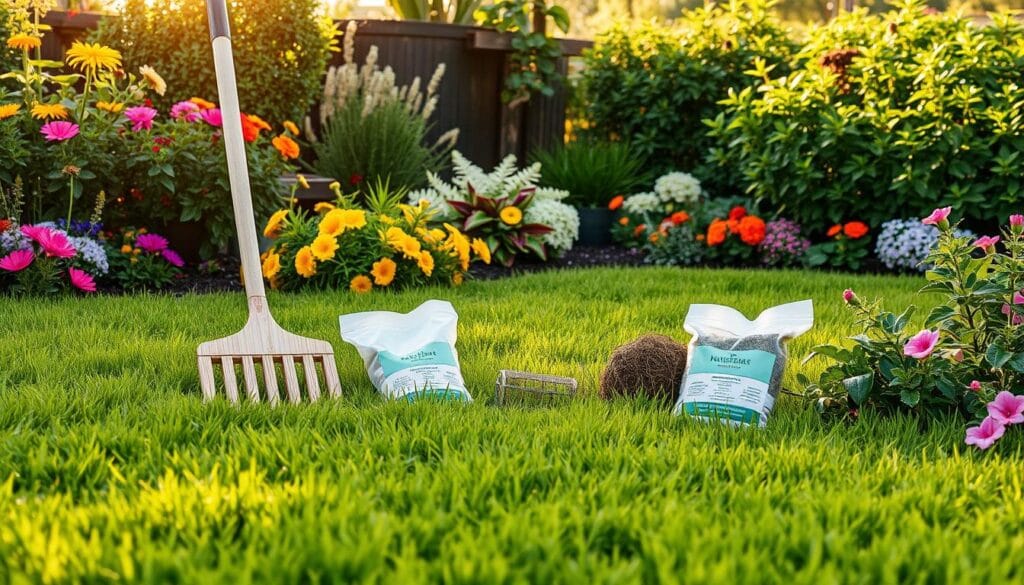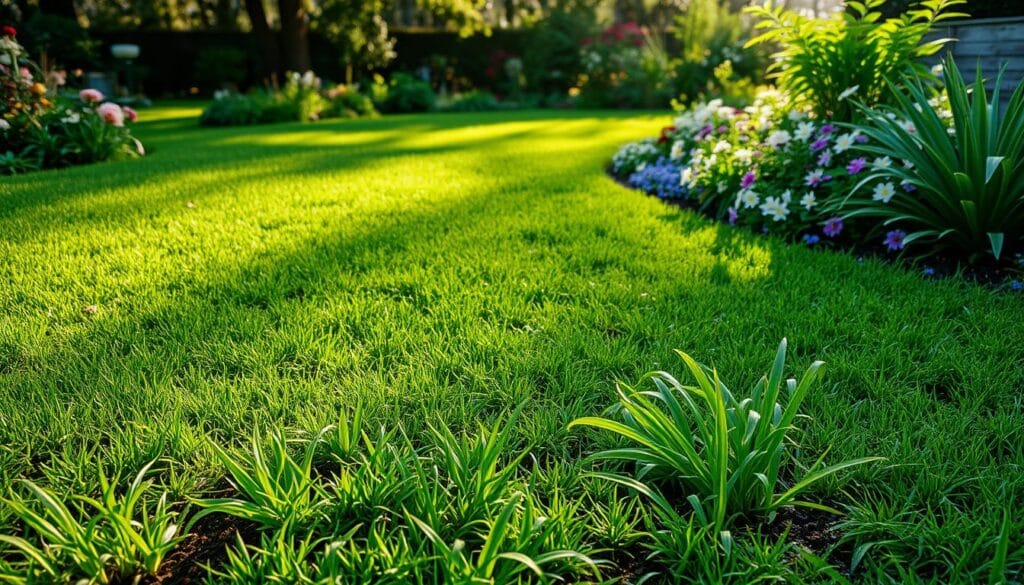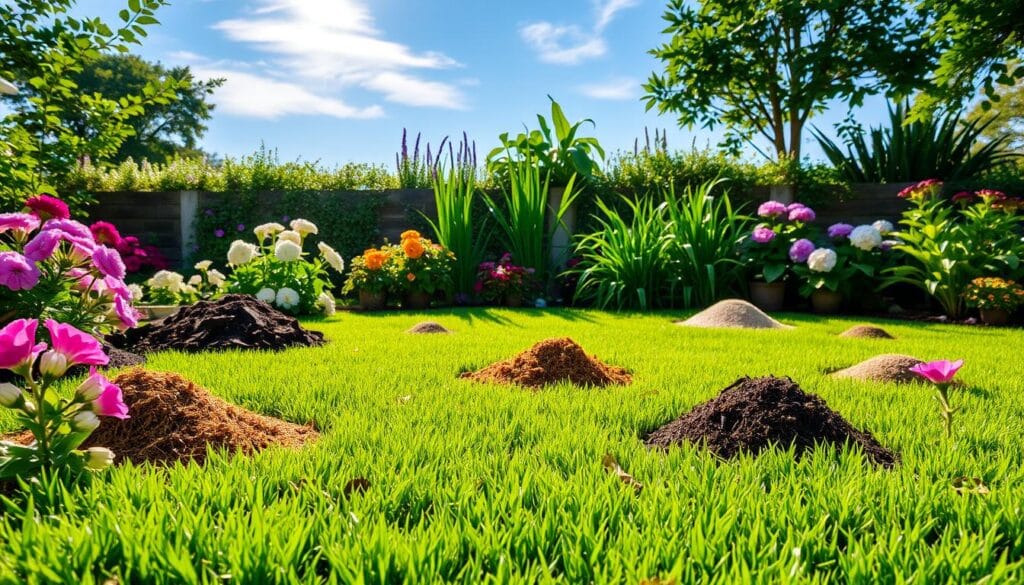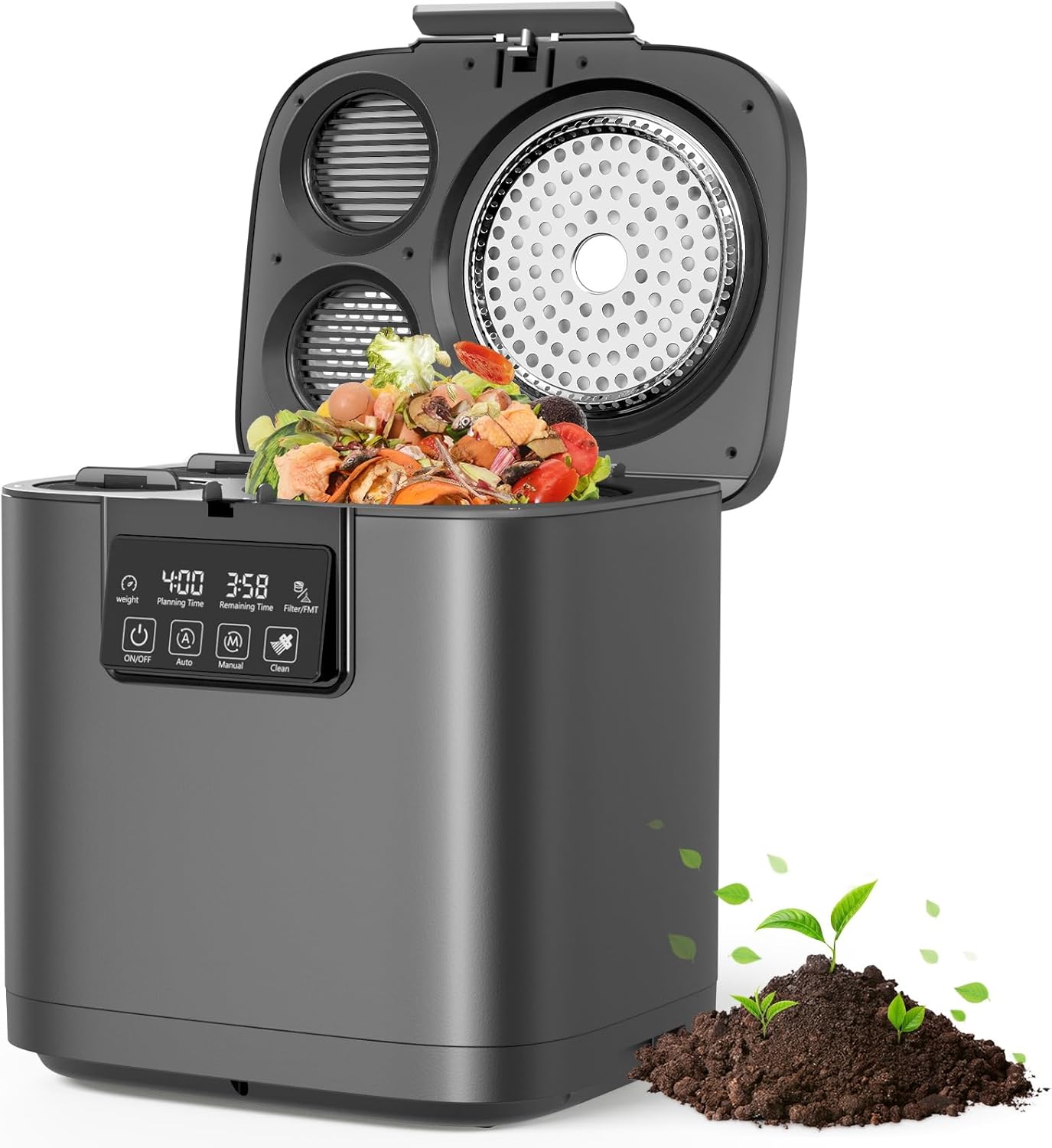When you step outside, you want your lawn to be beautiful and safe. Chemical-free lawn care makes this possible. It’s easy to do by using organic methods. This way, your lawn stays green without harmful chemicals.
Imagine enjoying your yard without worrying about chemicals harming your family or the planet. Organic lawn care is safe and eco-friendly. It also uses less water, which is great for saving water.
Choosing chemical-free lawn care is a big step towards a healthier yard. It’s good for the planet and reduces your carbon footprint. Organic lawn care has many benefits, like reducing greenhouse gases and supporting biodiversity.
Key Takeaways
- Chemical-free lawns are safer for children and pets, eliminating the risk of exposure to harmful pesticides and herbicides.
- Organic lawn care requires less water and promotes healthier soil structures, making it a more sustainable option.
- Conducting a soil test is essential for organic lawn care, helping you identify areas for improvement.
- Organic lawn fertilizers release nutrients more slowly, providing a steady diet for your lawn.
- By adopting chemical-free lawn care practices, you’re contributing to a more eco-friendly community and reducing your carbon footprint.
- Mulching grass clippings back into the lawn is a recommended practice for organic lawn maintenance, providing nitrogen and organic matter for the soil.
- Chemical-free lawn care is a key part of natural lawn maintenance, helping you create a beautiful and thriving lawn without harming the environment.
Understanding Chemical-Free Lawn Care
Thinking about switching to a chemical-free lawn? It’s key to know the good and the bad. Eco-friendly lawn care lets your grass and plants grow strong without harming the planet. Pesticide-free services mean less danger for your family and pets.
Chemical-free lawn care cuts down on harmful emissions and boosts local wildlife. It also helps keep pests in check naturally. For example, ladybugs and praying mantises are great at controlling pests. By going green, you make your outdoor space healthier and more eco-friendly.
Benefits of Going Chemical-Free
Here are some perks of chemical-free lawn care:
- Less water pollution
- More support for local wildlife
- Healthier soil and plants
- Less greenhouse gas emissions
Common Myths about Organic Lawn Care
Some think organic lawn care is pricey or time-consuming. But, with the right methods and tools, you can have a beautiful lawn affordably. Choosing eco-friendly products and services helps the planet and reduces your impact.
Essential Tools for Chemical-Free Lawn Maintenance
Keeping your lawn chemical-free requires the right tools and products. A lawn mower with a mulching attachment is key. It leaves grass clippings on the lawn, which act as natural fertilizer. A rotary sprinkler system and a moisture meter are also vital. They help save water and prevent overwatering.
For a green lawn, use sustainable products like organic fertilizers and compost. These support a healthy soil ecosystem and promote natural lawn care. Organic fertilizers like alfalfa meal, Chilean nitrate, and feather meal are good choices. They help your lawn thrive without harming the environment.

Adopting eco-friendly practices is also important. Mow your lawn at 3-4 inches and water deeply but less often. This encourages deep-root growth and drought resistance. By following these tips and using the right tools and products, you can have a beautiful, sustainable lawn. It will be safe for you, your family, and the environment.
Recommended Gardening Tools
- Lawn mower with a mulching attachment
- Rotary sprinkler system
- Moisture meter
- Organic fertilizers (e.g. alfalfa meal, Chilean nitrate, feather meal)
- Compost
Sustainable Lawn Care Products
Some popular sustainable lawn care products include:
| Product | Description |
|---|---|
| Organic fertilizers | Natural alternatives to synthetic fertilizers |
| Compost | Rich in nutrients and microorganisms, promotes healthy soil |
| Natural pest control products | Non-toxic alternatives to chemical pesticides |
Choosing the Right Grass for Your Climate
Choosing the right grass is key for a healthy lawn. For organic lawn care, think about your climate and where you live. Cool-season grasses like Kentucky Bluegrass and Fescue work well in cold winters and mild summers. This is true for the Northeast and Midwest.
Warm-season grasses, like Bermudagrass and Zoysia, are best for hot and humid areas. These are common in the Southeast and Gulf Coast. Picking a grass native to your area cuts down on water use and upkeep. It’s a smart eco-friendly lawn care move.
Here are some top grass picks for different areas:
- Kentucky Bluegrass and Fescue for the Northeast and Midwest
- Bermudagrass and Ryegrass for the Southeast
- Bahiagrass and Centipedegrass for the Gulf Coast
By picking the right grass for your climate and using sustainable lawn care methods, you can have a lush lawn. It will need less work and care.

| Grass Type | Region | Climate |
|---|---|---|
| Kentucky Bluegrass | Northeast and Midwest | Cool-season |
| Bermudagrass | Southeast | Warm-season |
| Bahiagrass | Gulf Coast | Warm-season |
Organic Fertilizers: Natural Alternatives
Using organic fertilizers is a smart choice for natural lawn care. They give your lawn the nutrients it needs without harming the environment. These fertilizers come from compost, worm castings, and aged manure. They are a safer choice than synthetic fertilizers and help keep your lawn green.
Organic fertilizers like blood meal, fish pellets, and seabird guano are good for your lawn. They have different amounts of nitrogen, phosphorus, and potassium. For example, a blood meal has lots of nitrogen but no potassium. Fish pellets have a mix of nitrogen and phosphorus.
Types of Organic Fertilizers
- Blood meal: 10% Nitrogen, 1% Phosphorus, 0% Potassium
- Fish pellets: 7% Nitrogen, 7% Phosphorus, 2% Potassium
- Seabird guano: 12% Nitrogen, 8% Phosphorus, 2% Potassium
How to Apply Organic Fertilizers
To use organic fertilizers right, follow the label’s instructions. Know your lawn’s needs to avoid overfertilizing. This way, you help your lawn and the environment.

| Organic Fertilizer | N-P-K Values | Benefits |
|---|---|---|
| Blood meal | 10-1-0 | Promotes healthy lawn growth |
| Fish pellets | 7-7-2 | Encourages beneficial microbes |
| Seabird guano | 12-8-2 | Improves soil health and structure |
Effective Weed Control without Chemicals
Keeping your lawn weed-free without using chemicals is key to eco-friendly lawn care. Physical methods like hand-pulling or using a weed puller are effective. They remove the weed and its roots, stopping it from coming back.
Using mulch is another way to stop weeds. Organic mulch, like wood chips or pine needles, keeps weeds from growing. It also helps keep the soil moist and prevents erosion.
Non-toxic treatments like boiling water, vinegar, or iron-based products can also kill weeds. These methods are good for the environment. For example, boiling water can kill weeds, and vinegar can break down weed cell walls.

- Mow your grass higher to prevent weeds from pushing through the soil
- Water your grass deeply but infrequently to starve weeds of water sources
- Use landscape fabric or organic mulch to suppress weed growth
- Consider using household items, such as vinegar or rubbing alcohol, as weed killers
By using physical methods and non-toxic treatments, you can have a beautiful, chemical-free lawn. This approach is good for your lawn and the environment.
| Weed Control Method | Description |
|---|---|
| Physical Removal | Hand-pulling or using a weed puller to remove entire weed |
| Mulch | Applying a layer of organic mulch to suppress weed growth |
| Boiling Water | Pouring boiling water directly onto weeds to kill them |
| Vinegar | Using vinegar as a contact herbicide to break down weed cell walls |
Natural Pest Control Strategies
Keeping your lawn healthy and sustainable means using natural pest control. As part of your organic lawn care routine, add beneficial insects like ladybugs and lacewings. These natural predators help control pests without chemical pesticides. This supports a balanced ecosystem and green lawn care practices.
Homemade pest deterrent recipes are also effective. Neem oil and diatomaceous earth are great for keeping pests away. Using these in your natural lawn maintenance routine makes your lawn healthier and more sustainable.
Choosing natural pest control methods reduces your need for chemical pesticides. This makes your lawn care routine more sustainable and eco-friendly.
| Pest Control Method | Description |
|---|---|
| Neem oil | A natural insecticide from neem tree seeds |
| Diatomaceous earth | A natural powder that dehydrates and kills pests |
The Importance of Soil Health
Soil health is key for a thriving lawn. Testing your soil is vital for eco-friendly lawn care. It shows nutrient levels and pH, helping you fix any issues.
Soil test kits are easy to use. They help you balance your soil, making it healthy for your lawn. This is a safe way to care for your lawn.
Testing Your Soil
Soil testing keeps your lawn healthy. It shows nutrient levels like nitrogen and potassium. This info helps you fertilize your lawn right.
Techniques for Improving Soil Quality
Improving soil quality is easy with organic matter and cover crops. These methods boost nutrient levels and soil health. They make your lawn better for sustainable care.
- Improved water retention
- Increased nutrient availability
- Enhanced soil structure
- Reduced soil erosion
Using these methods in your lawn care makes your lawn strong. It fights pests and diseases and needs less care over time.
Watering Practices for a Sustainable Lawn
Working towards natural lawn care means using water wisely. Deep, less frequent watering cuts water use by 40%. Smart irrigation systems can save up to 50% more by adjusting to the weather. This method is good for the planet and your wallet.
Watering at dawn or dusk is best. It cuts down on evaporation and gets water to the roots. A moisture meter helps avoid too much water, which harms your lawn.
Try drip irrigation and rain barrels to save water. Drip irrigation sends water straight to the roots, cutting down on waste. Rain barrels store rainwater for later use, saving tap water.
Native plants and drought-resistant grass need less water. They’re made for your local climate and soil, needing less care. Choosing these can make your lawn beautiful and water-efficient.
Seasonal Lawn Care Activities
Starting your eco-friendly lawn care journey means looking at your lawn’s changing needs. By using sustainable practices, you can make your lawn healthy and safe for your family and the planet. We’ll talk about the key steps for each season to help your lawn stay lush and green.
In spring, focus on aerating and fertilizing your lawn. Use a balanced, slow-release fertilizer to help roots grow deep. Choose organic options to cut down on pollution. In the fall, clean up leaves and get your lawn ready for winter with a winterizer to fight cold.
- Mow your grass at the right height for your climate and grass type
- Water deeply but not too often to help roots grow
- Use natural pest control, like beneficial insects or homemade recipes
By following these seasonal tips, you’ll be on your way to a beautiful, eco-friendly lawn. It will need non-toxic treatments and won’t harm the environment.
Every small change helps, and starting with one or two sustainable practices each year can make a big difference. So, start now and enjoy a healthy, thriving lawn that’s good for you and the planet.
FAQs about Chemical-Free Lawn Care
Starting your journey to a lush, organic lawn might raise questions. You might wonder if natural lawn care works well and if it’s affordable. Don’t worry, with the right info and methods, you can have a beautiful, eco-friendly lawn.
Common Concerns Addressed
Some people think organic products aren’t as good as chemical ones. But, organic fertilizers and natural weed control can work well if used right. Just be patient and let your lawn get healthier over time.
Resources for Further Learning
Looking for more help on chemical-free lawn care? Check out books, online courses, or local extension services. With the right knowledge and commitment, you can have a green lawn that’s good for your family and the planet.
FAQ
What are the benefits of growing a chemical-free lawn?
A chemical-free lawn is safer for your family and pets. It also cuts down on harmful chemicals and supports local wildlife. Plus, it helps reduce pollution.
Is chemical-free lawn care more expensive or time-consuming?
Many think it costs more or takes more time. But, with the right tools, it’s easy and affordable. You can have a green lawn without spending a lot or too much time.
What are the essential tools for chemical-free lawn maintenance?
You’ll need a lawn mower with a mulching attachment, a weed puller, and a soil test kit. Also, use organic fertilizers and eco-friendly pest control.
How do I choose the right grass for my climate?
Pick the right grass for your climate. Think about your soil, sunlight, and temperature. Native grasses and drought-resistant types like buffalo grass are good choices.
What are the benefits of using organic fertilizers?
Organic fertilizers feed your lawn without harming the environment. Options like compost, worm castings, and aged manure are great. They improve soil health and release nutrients slowly.
How can I control weeds without chemicals?
Pull weeds by hand or use a weed puller. Organic mulch also helps control weeds. It keeps the soil moist and prevents weed growth.
What are some natural pest control strategies?
Use beneficial insects like ladybugs and lacewings. Homemade pest deterrents like neem oil and diatomaceous earth are also effective. These methods keep pests away without harming the environment.
How do I test and improve my lawn’s soil health?
Test your soil to know its nutrient levels and pH. Add organic matter and use cover crops to improve it. This makes your lawn healthy and sustainable.
When is the best time to water my lawn?
Water in the early morning to reduce evaporation. Use water-saving methods like drip irrigation and rain barrels to save water.
What are some essential seasonal lawn care activities?
In spring, aerate and fertilize with organic products. In fall, clean up leaves and prepare for winter by overseeding or mulching. These tasks keep your lawn healthy all year.
Source Links
- Tips for Achieving a Lush, Lively, and Organic Lawn
- 9 Easy Steps for Eco-Friendly Lawn Care
- Organic Lawn Care Without Pesticides
- Rainwater Harvesting for Gardening: 5 Amazing Benefits
- A Guide to Organic Lawn Fertilizer
- Natural Lawn Care Techniques | Gardener’s Supply
- A Guide to Eco-Friendly Lawn Care
- Organic Lawn Care | University of Maryland Extension
- Chemical-Free Weed Control: Easy and Effective Methods
- Seeding Success: Choosing the Right Grass Variety for Your Lawn
- An Ultimate Guide to Grass Types
- How Can I Fertilize My Lawn Without Chemicals?
- How to Kill Weeds Without Harmful Chemicals—and Keep Them From Coming Back
- 11 Non-Toxic Ways to Kill Weeds
- What Is Organic Pest Control?
- 15 Natural Pest-Control Strategies for Your Yard and Garden
- Eco-Friendly Organic Lawn Care Services | North Eastern Tree
- Why Organic Lawn Care is Essential (w/ 5+ Lawn Care Tips)
- How Sup-R-Soil Improves Soil Health and Lawn Vitality
- The Benefits of Organic Lawn Care: A Comprehensive Guide – Organic Lawns
- Eco-Friendly Lawn Care Practices – Lawnhiro Blog
- Conserve Water In Your Landscape
- How to Create an Eco-Friendly Lawn (That
- A Comprehensive Guide to Seasonal Lawn Maintenance Schedule
- Top Fall Lawn Care Steps You Need to Take Before Winter Hits
- Sustainable Lawn Care Guide
- Organic Lawn Care & Management 101: FAQ, Tips, & More
- Dangers of Lawn Chemicals: Impacts and Alternatives – The National Wildlife Federation Blog





Pingback: DIY Vertical Planters: 7 Creative Hacks for Stunning Gardens
Pingback: Sustainable Vegetable Gardening Success in Just a Few Steps